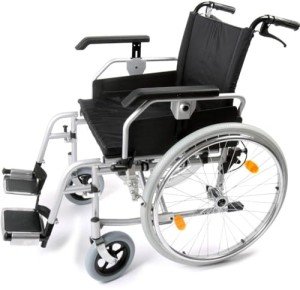Bariatric Wheelchair Seat Width
Seat Width

Having the appropriate seat width is very important to wheelchair users who invest longer durations in their chairs. Too narrow a seat will cause pressure on the hips and thighs which could lead to sores or pressure points. Having too large a seat can likewise make it challenging for the user to reach the hand rims to move themselves or maneuver in little spaces.
To measure the appropriate seat width a person would rest on a chair usually and have their measurement taken across their lap at the largest point which is normally their hips. A wheelchair determining tape can be utilized to determine this, however a yard stick is chosen as it avoids individuals from covering the tape around their hips which would offer an inaccurate result.
The basic wheelchair seat width is 16" (narrow grownup), 18" (standard adult), and 20" (large grownup). For bariatric clients, a 24" seat is offered. This sturdy extra wide bariatric wheelchair from Medline includes swing-away footrests, a carbon steel frame with rust- and chip-resistant chrome plating, and easy-to-clean vinyl upholstery. self propelled bariatric wheelchair has a weight capacity of 500 pounds.
Seat Depth
Typically, the seat depth of a bariatric wheelchair was added 2" to the measurement taken at the user's widest point (generally their hips). This was meant to accommodate additional layers of clothing that might be used during winter. However, this practice is ending up being less common as wheelchair users have the ability to invest more time indoors and are not wearing long coats. This makes the seat depth of a chair lesser when picking a bariatric wheelchair. However, it is still crucial to select an alternative that uses sufficient assistance for bigger users.
The Medline folding extra wide bariatric manual wheelchair includes a comfy 24" seat width and a heavy-duty slide tube silver vein frame. It likewise has an adjustable axle and tool-free elevating legrests.
Seat Height
When it comes to determining the correct wheelchair seat width you ought to constantly measure from the user's widest point which is generally their hips. You will also need to think about whether the user is going to be wearing a winter coat as this may include 2" to the width needed.
When a wheelchair remains in use it must only be run on level surfaces with the wheel locks totally engaged. This is to avoid the chair from being able to move inclines that are 10 degrees or higher. It is likewise important to keep in mind that any activity that might move the center of mass in the chair ought to be made with care. This consists of reaching for items that require the person to lean out of their seat or trying to stand from it.
Whenever you have the chair in usage it is recommended that you regularly check it for damage and lube any areas that are deemed necessary. For instance, the casters should be oiled by removing the caster fork and using a multi-purpose grease to apply to the caster stem bearings. Similarly, the foot plates can be adjusted by loosening the bolt and then moving them to the preferred position. This permits the feet to sit easily on the footplate and prevents any pressure points from forming. This can be very uncomfortable for the user and if left ignored, can cause pressure sores.
Weight Capacity
Bariatric wheelchairs are developed to support more weight than basic wheelchairs. This makes them sturdier and better geared up to handle falls. They are likewise typically bigger and broader, making them less maneuverable in tight spaces than basic wheelchairs. They need vehicles with special ramps and lifts to pack them, in addition to chauffeurs who know how to finest transport them from one place to the next.
When choosing a wheelchair, consider its weight capacity as it will be the main determining consider whether it will accommodate your passenger's needs. The weight capacity of the chair is frequently listed as a fixed load, meaning that it shows the quantity of weight the chair can comfortably hold while standing still. Nevertheless, some manufacturers likewise note an active load that is based on a drop test and can imitate the impact of someone taking a seat in the chair. This might be a more dependable measurement of the weight limit, depending on your needs.
If you plan to carry out activities that move your center of gravity in the seat (such as grabbing items), make certain to have front casters pointed in a forward direction and wheel locks engaged so the chair will not topple. Also, examine that casters are lubricated frequently to prevent excessive wear and abrasions. The lubrication treatment includes getting rid of the fork, separating the caster from the wheel, and greasing the caster stem bearings with high-quality multi-purpose grease.
